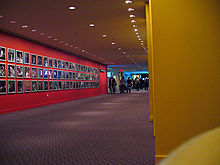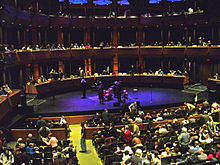|
Jazz at Lincoln Center
Jazz at Lincoln Center is an organization based in New York City. Part of Lincoln Center, the organization was founded in 1987 and opened at Time Warner Center (now Deutsche Bank Center) in October 2004. The organization seeks to “represent the totality of jazz music – educationally, curatorially, archivally, and ceremonially.”[2] They advocate for jazz, culture, and arts education globally. Wynton Marsalis is the artistic director and the leader of the Jazz at Lincoln Center Orchestra. The center hosts performances by the orchestra and by visiting musicians. It is home to the New York City Opera.[3] Many concerts are streamed live on the center's YouTube channel. The center also presents educational programs in its home buildings, online, and in schools throughout the country. The organization reaches approximately 3 million people of all ages every year through concerts (where more than 90 percent of seats for major shows are sold), tours, musical instruction programs, sheet music, recordings on their label (Blue Engine), and live performances on their platform JAZZ LIVE. The center has large speakers throughout the building that constantly play the music of great jazz artists like Ella Fitzgerald, Dizzy Gillespie, Louis Armstrong, etc. History During the mid-1980s, the Lincoln Center sought to attract new and younger audiences. The space wasn’t used during the summer and the organization wanted to find ways to fill the halls while resident companies performed elsewhere. Jazz enthusiasts on the Lincoln Center campus fought for jazz to be recognized by the organization. In a 1986 report the organization said, “Lincoln Center should focus on excellence in its course offering and that no compelling case can be made for adding a constituent in an area like jazz.”[4] This was after the third proposal from then director of visitor services, Alina Bloomgarden, to introduce a permanent jazz program to the Lincoln Center. It was believed that jazz audiences would be too rowdy. Bloomgarden then decided to invite Wynton Marsalis to help her plan a summer concert series. In order to succeed, this concert series had to show commercial viability and merits of both the music and community it came from. In 1987, trumpeter Wynton Marsalis was involved in starting the Classical Jazz concert series, the first series of jazz concerts at Lincoln Center.[5] The concert series began in August 1987 and they celebrated women in jazz. This included Betty Carter, Sasha Dalton, Marian McPartland, and others. Given the high stakes, success of this concert series was pertinent. At this point in time, many great jazz innovators had passed away, jazz clubs were shutting down, not many colleges and universities had jazz programs, and there was a rise in commercial aspirations with electronic music. It was also a polarizing time in the United States with many places still being racially integrated, the AIDS epidemic, boost in militarization and globalization with the Cold War, and Ronald Regan’s War on Drugs increasing mass incarceration. By their second year, they had their own radio services on the National Public Radio and began touring. A sense of what Marsalis was saving was recorded in this three part suite, "The New Orleans Function," that was styled after New Orleans funeral marches.[6] Stanley Crouch (involved in finding Jazz at Lincoln Center) wrote an impassioned oration that was delivered by Reverend Jeremy Wright. This sermon is read as a statement of purpose for what Jazz at Lincoln Center would become:
Gordon Davis, member of the Lincoln Center Board and founding chair, saw the success of the summer concert series and advocated for a permanent jazz program. The board agreed and by 1996, Jazz at Lincoln Center was elevated to full constituency along with the City Ballet, Metropolitan Opera, and houses dedicated to European Arts. In 1996, the Jazz at Lincoln Center organization became a constituent of Lincoln Center next to organizations such as the New York Philharmonic and the Metropolitan Opera. The budget for Jazz at Lincoln Center was $4 million in 1996, compared to $150 million for the Metropolitan Opera.[7] In 2016, its budget was over $50 million.[8] Wynton Marsalis has been artistic director since 1987. Greg Scholl became executive director in 2012.[9] Marsalis leads the Jazz at Lincoln Center Orchestra, which performs in the Appel Room and the Rose Theater in addition to extensive international tours. Concerts are also broadcast live online. Educational programs are broadcast on the center's YouTube channel. Since 2015, the orchestra's albums have been issued on its own label, Blue Engine Records.[5] The center distributes jazz curriculums to high schools through its Essentially Ellington program. Professional musicians visit schools through the Let Freedom Swing program. The center runs a Middle School Jazz Academy, a High School Jazz Academy, and a Summer Academy, all in New York City, all of them with free tuition. Every year the orchestra tours and visits schools throughout the U.S.[5] The Essentially Ellington High School Jazz Band Competition and Festival takes place every year at Jazz at Lincoln Center. Rose Hall Buildings of Lincoln Center Buildings and structures in Lincoln Center: 1 Samuel B. and David Rose Building (includes Walter Reade Theater)2 Juilliard School3 Alice Tully Hall4 Vivian Beaumont Theater (includes Mitzi E. Newhouse Theater and Claire Tow Theater)5 Elinor Bunin Monroe Film Center6 David Geffen Hall7 New York Public Library for the Performing Arts (includes Bruno Walter Auditorium)8 Metropolitan Opera House9 Josie Robertson Plaza with Revson Fountain10 Damrosch Park11 David H. Koch Theater12 David Rubenstein Atrium13 Jazz at Lincoln CenterThe performing arts complex, Frederick P. Rose Hall, was designed by Rafael Viñoly and is located on the fifth floor of Deutsche Bank Center (originally Time Warner Center). The $131 million facility opened in fall 2004 and was the world’s first performance, education, and broadcast facility all devoted to jazz. It was engineered specifically for the warmth and clarity of jazz. Rose Hall consists of three venues: Rose Theater, The Appel Room,[10] and Dizzy's Club, named after trumpeter Dizzy Gillespie. The Hall also contains the Irene Diamond Education Center with rehearsal and recording rooms.The location was criticized for being within a high-end shopping mall at Columbus Circle and isolated from the main Lincoln Center that was four blocks away. JALC counteracted this by saying that this house of consumerism “showcases the music born from a freedom struggle, one that encourages both players and listeners to reach for higher ideals.”[11] Leaders of Jazz at Lincoln Center undertook construction of a facility that had proper acoustics for swing and blues oriented jazz. They also wanted this facility to properly house the institution’s educational and archival pursuits. To start gaining traction, Marsalis collaborated with popular musicians outside of jazz such as Stevie Wonder, Paul Simon, and Bob Dylan. Not only did this bring in a larger audience, it also allowed for performances with rich tension between swing, rock, and R&B.[12] Rose Theater has a “floating box-in-box construction” that has no rigid structural connections to Jazz at Lincoln Center's other performance halls.2 The venue has 1,233 seats and is adaptable for opera, dance, theater, film, and orchestral performances. In order to minimize outside noise and to remain both quiet and intimate, the space sits on rubber isolation pads. In order to maintain adaptability, Rose Hall has moveable seating towers that can be put into concert mode and theater mode. When in concert mode, seats are behind and around the musicians to serve as an acoustical and visual function. This also allows for more seating at concerts. When in theater mode, the towers are stored in an air caster system. This allows for a platform when opera, ballet, or modern dance require scenic elements. The Appel Room contains 583 seats with an informal and intimate setting. The room normally has seven separate seating levels, but it can be converted into four to accommodate for dancing and mobility. The room has a 50 foot high glass wall that overlooks Central Park. This wall is angled slightly upward, allowing for sound to be reflected from the atrium and stage monitors directly into the ceiling. Panels are hung from the ceiling and catwalks to diffuse and absorb sound. Dizzy’s Club Coca-Cola (named after American jazz trumpeter Dizzy Gillespie) contains 140 seats and was designed as an intimate jazz club for live trios, pianists, and vocalists. The room has a city view of Columbus Circle and Central Park. It was designed to have a “golden” sound to encourage artist-audience interaction (similar to early New York City jazz clubs). ReceptionSince Jazz at Lincoln Center’s inception, critics have accused Wynton Marsalis of being an elitist who hasn’t embraced diversity and has failed to foster music experimentation. Matthew Shipp (pianist) wrote an article in 1998 criticizing the center. He said that rather than fostering a performance space, the center institutionalized jazz and created an environment where music goes to die. By institutionalizing jazz, Shipp claimed that something illegitimate becomes legitimate, which takes away from the spirit of jazz. Others claimed that Marsalis would “return artistic seriousness and market viability to a genre that had lost its way… [and] radiated a brashness that all but dared critics to reject the savior mythology.” Hall of FameThe Nesuhi Ertegun Jazz Hall of Fame is named for Nesuhi Ertegun, co-founder of Atlantic Records. A 60-person international voting panel, which includes musicians, scholars and educators from 17 countries, is charged to nominate and select "the most definitive artists in the history of jazz for induction into the Hall of Fame".[13] Inductees have included:[14][15][16][17] 2004
2005
2007
2008
2010
2013
2014
2015
2016
2017
2018
2019
2020
2022
2023
2024
See also
References
External links
|
||||||||||||||||||||||||||


